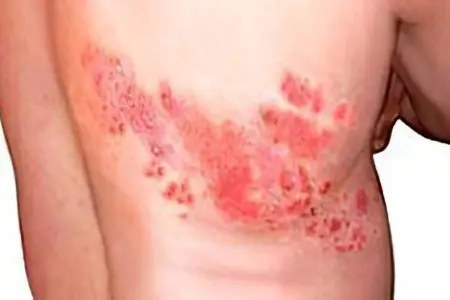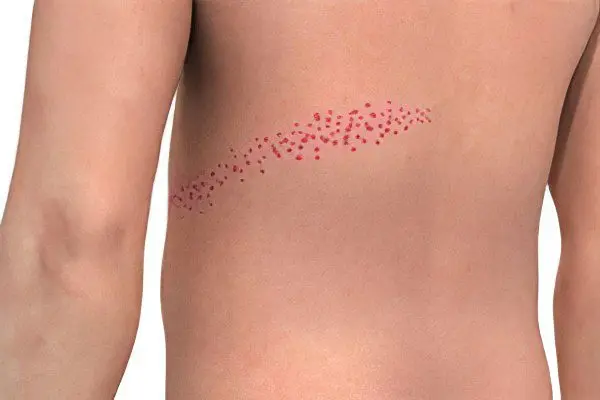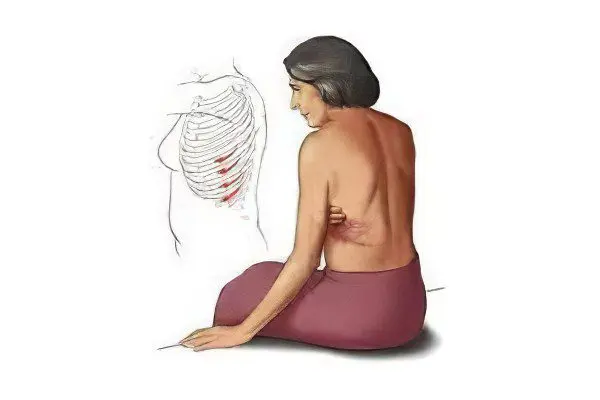Contents
- What is herpes zoster?
- Herpes zoster symptoms
- Causes of herpes zoster
- Consequences and complications of herpes zoster
- Is herpes zoster contagious?
- Herpes zoster treatment
What is herpes zoster?

Herpes zoster is a sporadic disease caused by reactivation of the herpes simplex virus type III (Varicella Zoster virus). The disease is characterized by a predominant lesion of the skin and nervous system with severe complications.
Lifelong hidden carriage of varicella zoster was found in approximately 20% of the inhabitants of our country who had chickenpox in childhood. Asymptomatic carriage of the “dormant” virus can be lifelong. The main refuge for him are the nerve cells of the body. Under the action of internal and / or external agents, the virus is activated.
The risk group includes all people with a latent form of Varicella Zoster virus, but to a greater extent having:
Age fifty and over;
chronic diseases;
Violations of the cellular link of the immune system;
Women with complicated pregnancy;
Children who have had chickenpox;
Persons of young and middle age with HIV.
The frequency of detection of herpes zoster is 5-12 cases for every 100 thousand citizens. Approximately 80% of patients are people over fifty years old. Older women are affected twice as often as men. There are no gender differences in young and middle age. The disease ends with severe, in 1-5% extremely severe complications.
Herpes zoster HIV infected
In people aged 20 to 40 years, OH can serve as a marker of HIV infection, it is detected in approximately 10-25% of HIV carriers, while:
The average age of the diseased is 32±4 years versus 65±5 years in persons not infected with HIV;
Tendency to relapse – 60% versus 1,3% in persons not infected with HIV;
Deep skin lesions – 30% versus 5% in people not infected with HIV.
Herpes zoster in cancer patients and organ transplant patients
The incidence of herpes zoster in patients undergoing chemotherapy or drug prevention of transplanted organ rejection ranges from 25 to 50%, mortality is up to 5-7%.
Herpes zoster in pregnancy
Detection rate: 7 cases for every 100 women. The clinical course of the disease in the first trimester of pregnancy is one of the reasons for its termination due to placental insufficiency, intrauterine hypoxia and fetal growth retardation.
Shingles in children
In essence, this means re-infection of a child who previously had chickenpox during the first year of life, or who became infected in utero from a mother who first contracted chickenpox during pregnancy. Evidence for the severity of shingles in children is lacking, with the rare exception of immunocompromised children.
Herpes zoster symptoms

OH is characterized by a variety of symptoms that depend on the stage of pathogenesis. There are four main periods:
Prodromal – from zero to the third, maximum tenth day;
Acute – from the tenth to the twentieth day;
Convalescence – from three weeks to three months;
Long-term effects – from three months to three years.
Symptoms of the prodromal stage consist of three components: general clinical, neurological disorders and skin rashes.
Febrile temperature from 38 to 39оC, sometimes subfebrile from 37-37,5оC. The fever lasts no more than five to ten days. Prolonged hyperthermia is characteristic of herpes zoster complicated by meningitis or encephalitis. General symptoms are observed in about 20% of cases.
An increase in regional lymph nodes, mainly on one side (on the neck, in the armpit, under the collarbone, in the groin) in places of itching, pain and rashes.
Soreness at the site of the rash (constant, paroxysmal, from touch, feels like burning, stabbing), which often persists for several months after recovery – “post-zoster neuralgia.”
A blistering rash on one side of the body – on the chest, abdomen or face in the form of a ribbon or patch encircling the entire area. In 70% of patients, the rash appears within the first three days of the onset of the fever.
Localization of rashes
The most characteristic places of localization of rashes with herpes zoster are the chest, head, neck and lower back. The approximate ratio of rashes on different parts of the body:
Chest – 55%;
Head – 23%;
Neck – 12%;
Loin – 10%.
Rashes are localized in the area of dermatomes – areas of the skin innervated from the root of the nerve affected by the virus. Knowing the topography of dermatomes and the localization of lesions on the patient’s body, it is possible to determine which branch of the nerve is involved in pathogenesis. Girdle projection of thoracic dermatomas on the body explains the name of the disease.
The pathogenesis of rashes on the dermatome

Gradual pathogenesis of rashes on the dermatome:
Erythema (redness);
Papules – one to two days;
Vesicles merging into groups of vesicles – five to seven days;
Crusts in place of the vesicles, the process is completed by the 30th day of the disease.
The erythema stage is very short or absent, the pathogenesis begins with papular rashes. If you do not carry out treatment, then the stage of rashes lasts about a month. A longer stage of rashes (up to two to four months) is evidence of the patient’s immunodeficiency. The intensity of the rash is different: from single to confluent forms of rash. Sometimes the rash does not form at all. This form is called “zoster without a rash” (zoster sine herpete).
There is also shingles on the mucous membranes. Instead of a rash, shallow red erosions form.
In patients without a history of immunodeficiency, the rash is localized in one, rarely in several dermatomes. It is noted that a rash localized, for example, in the left dermatome, rarely occurs in a similar right one, and vice versa. In immunodeficient conditions of the patient, a rash is localized in the dermatome and throughout the body – this is a generalized form of herpes zoster. With HIV infection in a patient, the localization of a rash scattered throughout the body is called a disseminated form of herpes zoster.
Pain in herpes zoster
Pain can be:
Only at the beginning of the disease;
Throughout the illness (about a month);
Long time after the disappearance of the symptoms of the disease.
Post-zoster pain is a pain syndrome lasting more than four months (120 days) from the onset of the disease.
Characteristics of post-zoster pain
There are three types of discomfort described by patients with post-anxiety pain syndrome:
Constant, including – burning, dull, deep, pressing;
Spontaneous, including – stabbing, pulling, shooting;
Provoked (up to 90% of all patients are isolated) – appears from touching the body, when dressing, covering with a blanket.
In the acute period, pain does not necessarily correspond to the intensity of the rash. It almost always increases at night under the influence of external stimuli, exposure to cold, heat or touch. Pain can also provoke tight underwear. Often there are phenomena of a paradoxical simultaneous combination of reduced and increased sensitivity of different parts of the body.
Herpes zoster is accompanied by inflammation of the nerve node – ganglionitis. One or more nodes may be involved in the pathogenesis. Nerve damage can be complicated by a rapid decrease in hearing or vision.
Options for the development of pathogenesis in individual nerve nodes:
The defeat of the V-pair of facial nerves and the trigeminal nerve. Localization of rashes – on the head, in the hairy or hairless zone, corresponding to one of the three branches of the nerve. Inflammation is accompanied by excruciating pain in the area of rashes, hyperthermia, swelling of the subcutaneous tissue of the affected side of the head. A detailed examination reveals points of increased pain along the trigeminal nerve.
Defeat of the VII pair of facial nerves, its geniculate node (Hunt’s syndrome). Manifested by rashes in the ear canal, on the mucous membrane of the tongue and palate. Accompanied by dizziness, pain on the side of the head with irradiation to the face, neck or back of the head. It ends with complications in the form of paralysis of the facial muscles, unilateral hearing loss, tinnitus.
Damage to the neck. This node is formed by the branches of the four cervical spinal nerves C1-C4. The disease is manifested by rashes in the neck and chest. Accompanied by burning pain, sometimes pain on palpation on one side in the head, face and neck. It ends with violations of the sensitivity of the skin, prolonged pain in the parts of the body innervated by the roots of the node.
The defeat of the cervicothoracic stellate node. It causes pain in the chest area, which resembles an angina attack. It ends with complications in the form of dysfunction of the innervated areas of the skin and internal organs. On the skin, a change in pigmentation, a violation of sweating, a decrease in tone are possible.
Damage to the nerve nodes of the coccygeal zone. Manifested by rashes in the anus and severe pain. Possible complications: violation (delay) of urination, lesions of the genital organs.
Ophthalmoherpes
Damage to the roots of the facial nerves that innervate the eye area is called ophthalmic herpes. The disease is manifested by keratitis, lesions of the sclera, iris and optic nerve in the form of its atrophy. Rashes, with the involvement of the roots of the optic nerves in the pathogenesis, are localized on one side of the head from eye level to the top of the head. In this case, rashes on the wings and the tip of the nose (Hutchinson’s symptom) are considered the most dangerous. The combination of two herpes viruses: Varicella zoster virus and Herpes simplex is the most common cause of facial paralysis (Bell’s palsy).
The diversity of pathogenesis underlies the clinical classification of herpes zoster.
Classification according to the localization of the pathogenesis of herpes zoster

Mandatory participation in the pathogenesis of symptoms of damage to the nervous system and skin rashes underlies the classification of herpes zoster.
Herpes zoster can manifest itself:
Meningitis, encephalitis, meningoencephalitis (inflammation of the brain and its membranes, their combinations);
Lesions of other organs of the nervous system (ganglionitis);
Eye lesions (inflammation of the conjunctiva, eyelids, iris, eyeball and cornea);
Eruptions scattered (disseminated) throughout the body;
Complications extending to other organs and systems;
Hidden course without rashes;
atypical symptoms.
Diagnosis and differential diagnosis of herpes zoster
The definition and differentiation of the disease is carried out on the basis of a clinical survey, external examination and palpation of the damaged areas.
Exclude the following similar pathologies:
Zosteriform lichen due to herpes simplex;
Contact dermatitis and insect bites;
Bullous pemphigoid.
Laboratory methods – PCR diagnostics, detection of a specific virus. A sample is taken from the vesicle.
Causes of herpes zoster
It has been noted that herpes zoster develops in people with homeostasis disorders due to aging of the body and / or damage to protective specific immunity. Other reasons for the development of pathology are known (see the beginning of the article).
Triggers remain unclear to the end – factors that push the body onto the path of development of the pathogenesis of herpes zoster. Many people who have all the prerequisites for the development of this disease (the presence of a latent virus, deep damage to the immune system) never get sick with herpes zoster.
The insidious mechanism of the development of the disease, the variety of symptoms and the relatively mild illness are factors that distract from the threat of serious consequences of OH for human health.
Consequences and complications of herpes zoster

Herpes zoster rarely ends in the death of the patient. However, there have been numerous cases of uncomfortable conditions of people after the illness. It is possible to develop damage to the cortex and substance of the brain, as well as the spinal cord, its membranes and roots.
Some patients complain about:
Local pain within six months after recovery – 25%;
The presence of pain reactions for more than six months – 16%;
Headaches and dizziness – 3%;
Movement disorders – 4,5%;
Acquired hearing loss – 2,7%;
Visual impairment – 1,8%.
Approximately 0,2% of patients develop cardiovascular insufficiency, ending with coronary artery disease and ischemic stroke, and sometimes progression of cancer. Retinal necrosis with a probability of 70-80% ends with the development of complete blindness.
Is herpes zoster contagious?
The first contact with the virus occurs in childhood, then the virus causes chickenpox. The disease proceeds according to a benign scenario. They don’t get sick again. Herpes zoster usually develops after reactivation of the herpes zoster virus.
The probability of transmission of Varicella Zoster virus from a patient to a healthy person is quite high, but this is not of great importance in the epidemic process, since herpes zoster is characterized by a sporadic course (isolated cases of the disease).
Meanwhile, compliance with the usual protective measures is a prerequisite for communicating with a patient with herpes zoster.
Herpes zoster treatment
Antiviral therapy includes a set of measures, including the use of antiviral, analgesic and anti-inflammatory drugs in the form of tablets and ointments. Immunocorrection, vitamin therapy and other methods are justified in cases agreed with the attending physician.
The maximum effect of specific therapy can be expected if treatment is started no later than 72 hours after the first clinical signs of herpes zoster are detected. Timely therapy significantly increases the likelihood of a quick recovery without complications.
In the treatment, specific antiviral drugs, NSAIDs, in advanced cases, corticosteroids and antidepressants are used. With a strong pain syndrome, it is possible to set up a novocaine blockade.
GlaxoSmithKline’s varicella vaccine Varilix has been registered in Russia, but there is no specific vaccine for herpes zoster.









